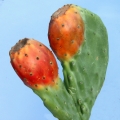




Your support is critical to our success.
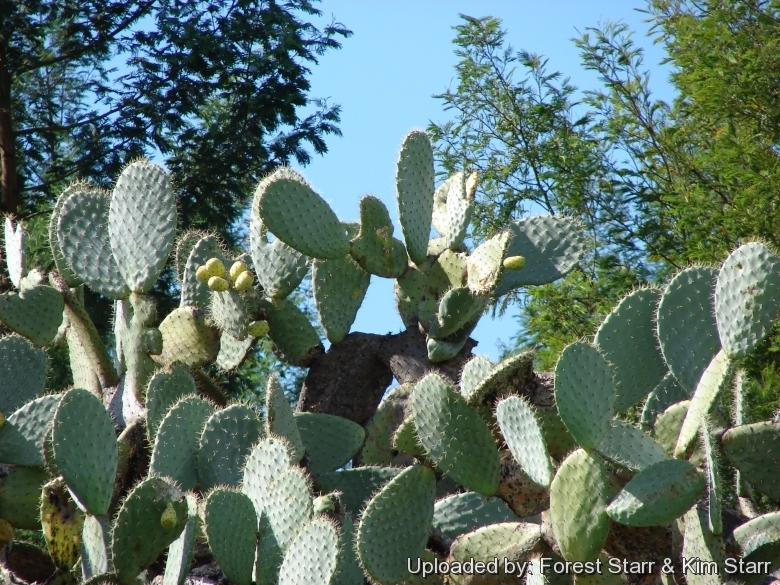
Origin and Habitat: The origin of Opuntia ficus-indicaSN|11631]]SN|11631]] is not known, probably Mexico, where it has been cultivated back to prehistoric times for about 8,000 years. The plant spread to many parts of the Americas in pre-Columbian times, and since Columbus, have spread all over the warm areas of the world, especially the Mediterranean Sea, about the Red Sea, in southern Africa, and in Australia, either cultivated for their fruits and for forage or as escapes. This spread was facilitated by the carrying of nopales (stem segments) on ships to prevent scurvy. It has also been extensively developed horticulturally. Noxious populations of this (and similar) species have been prolific in some areas; in Australia and parts of Africa, they are pests worthy of extermination.
Altitude: Cultivated from sea level to about 1500 metres above sea level.
Habitat: Opuntia ficus-indicaSN|11631]]SN|11631]] is extremely adaptable and thrives in droughty conditions, erratic rainfall and poor soils subject to erosion but it cannot withstand salinity and water-logging Opuntia ficus-indicaSN|11631]]SN|11631]]. It is also sensitive to freezing temperatures but extremely tolerant to high temperatures.
Synonyms:
- Opuntia ficus-indica (L.) Mill.
Opuntia ficus-indica (L.) Mill.
Gard. Dict., ed. 8. Opuntia no. 2. 1768 [16 Apr 1768]
Synonymy: 3
- Opuntia ficus-indica (L.) Mill.
- Opuntia vulgaris Mill.
- Platyopuntia vulgaris (Mill.) F.Ritter
ENGLISH: Indian fig opuntia, Barbary fig, Prickly pear
ALBANIAN (Shqip): Fiku i detit
ARABIC ( لعربية ): التين الشوكي, Kermus ennsara (Algeria), Kerma (Algeria), Hindîr (Morocco), Handiyya (Morocco)
CATALAN (Català): Figuera de moro, Figuera de pic, Figuera de pala, Fifuera de moro
CHINESE (中文): 梨果仙人掌, Xian tao, Ci li
CORSICAN (Corsu): Fica d'India
DANISH (Dansk): Kaktusfigen, Indisk figen
DUTCH (Nederlands): Vijgcactus, Woestijnvijg, Schijfcactus, Cactusvijg, Barbarijse vijge, Bloedvijg, Tuna cactus, Tuberous prickly-pear, Spineless cactus, Smooth prickly-pear, Smooth mountain prickly-pear, Prickly-pear cactus, Prickly-pear, Mission prickly-pear, Mission cactus, Indian-fig
FINNISH (Suomi): Viikunaopuntia
FRENCH (Français): Figuier de Barbarie, Cactus raquette, Oponce, Nopal, Figuier d'Inde, Figuier à raquettes, Figue de cactus, Figue de Barbarie, Chardon d'Inde
GERMAN (Deutsch): Stachelfeigen, Kaktusfeigen, Kaktusfeige, Indianische feige, Frucht des feigenkactus, Feigenkaktus
GREEK (Ελληνικά): Φραγκοσυκιά (Fragkosykia), Οπουντία η ινδική συκή
HAWAIIAN (ʻŌlelo Hawaiʻi): Panini, Papipi
HEBREW (עברית): צבר מצוי
HUNGARIAN (Magyar): Közönséges fügekaktusz, kaktuszfélék, fügekaktusz
ITALIAN (Italiano): Fico d'India, Ficodindia, Opunzia
JAPANESE (日本語): Opunchia
KINYARWANDA (Ikinyarwanda): Ikimungu
LITHUANIAN (Lietuvių): Figavaisė opuncija
NAHUATL (Nāhuatl): Nōchtli
NORWEGIAN (Nynorsk): Fikenkaktus
POLISH ( Polski): Opuncja figowa
PORTUGUESE (Português): Palma, Figueira tuna, Tuna, Piteira, Figueira da Índia, Figo do diabo, Tabaibeira, Tabaido, Palmatoria sem espinhos, Figueira da Barbária, Figo de pitoira, Figos da India, Figo de cacto
QUECHUA (Runasimi / Qhichwa simi): Tuna waraqu, Tunas
ROMANIAN (Română): Chumbo
RUSSIAN (Русский): Опунция инжирная, Опунция индийская (Opuntsiia indiiskaia), Самый обыкновенный (Samyi obyknovennyi)
SARDINIAN (sardu): Figu morisca, Figuindia
SICILIAN (Sicilianu): Ficu r'Inia, Ficupala, Ficu d'Innia
SILESIAN (ślůnski): Figowo uopůncyjo
SPANISH (Español): Palera, Higuera de pala, Pita, Higuera de chumbo, Chumbera, Tuna, Nopal, Higo chumbo, Tuna real, Tuna mansa, Tuna española, Tuna de Castilla, Tuna de España, Nopal pelón, Nopal de Castilla, Higuera chumba, Higuera, Higos de la India (Spain), Higos chumbos (Spain), Higo México, Higo de pala, Higo de cactus, Higo chimbo, Chumbua, Chumbo, Chumbera (Spain), Chumba, Cardón de México
SWEDISH (Svenska): Fikonkaktus
TELUGU (తెలుగు): భారతీయ నాగజెముడు, నాగజెముడు ఫికస్ ఇండికా
TURKISH (Türkçe): Hint inciri, Dikenli incir, Frenk inciri, kaynanadili
UPPER SORBIAN (Hornjoserbsce): Figowa opuntija
Description: Opuntia ficus-indica is a prickly pear cactus that has long been a domesticated crop plant important in agricultural economies throughout arid and semiarid parts of the world.
Habit: It is a large and bushy or sometimes erect and treelike perennial succulent with a definite woody trunk, 1-6 meters high, usually with a large top.
Root: Root-system spreads horizontally.
Trunk: Well-developed trunks 60-150 cm tall and up to 35 cm in diameter.
Stem segments (cladodes): Variable, narrowly to broadly obovate, oblong or spatulate-oblong, flattened, very thick, succulent, (20-)30-50(-80) cm long, 10-25 cm wide, 2-2,5 cm thick, sometimes even larger. The epidermis is green, very thick and waxy, thus very water repellent and sun reflecting.
Areoles: Small, narrowly elliptical, 2-6 cm apart, 2-5(-7) mm long, 3-4 mm broad (areoles perhaps oval to subspherical on young pads) usually spineless; glochids brown or yellow, numerous protruding 1-2 mm, soon dropping off. Some varieties are glochids-less.
Spines: Inconspicuous, absent or present in a few areoles, or 1-6 present in most of the areoles on each pad; spines usually white, tan or pale brown, deflexed and spreading, straight, flattened, subulate, to 1,2-2,5(-4) cm long, 0,6-0,9 mm wide at the base.
Leaves: Ephemeral, minute on young cladodes, subulate, green, 3 mm long and quickly fall.
Flowers: Large, 5-7(-10) cm long and broad, normally bright yellow to orange-yellow ( but also white, bright orange or red) with reddish or greenish centres, the inner perianth segments sometimes pink-tinged externally, 2,5-3 cm long, 1,5-2 cm broad. Ovary 5 cm long. Filaments and anthers yellow; style and stigma lobes greenish.
Fruit: Fruits ovoid to oblong, with a low, depressed umbilicus, 5-10 cm long, 4-9 cm in diameter, with glochids and sometimes spines, normally red to purplish, but also green, yellow or orange, fleshy, juicy, edible, persistent for several months. The pulp may be white-yellowish, orangish or purple-red.
Seeds: Irregularly discoid, grey, brownish or tan, 3-4(-5) mm in largest diameter.
Phenology: The flowers first appear in early May through the early summer in the Northern Hemisphere, and the fruit ripen from August through October. Flowering occurs on 1-2 year-old cladodes. Flowers open late morning
Cytology: 2 n = 88.
Remarks: In Mexico a spiny forms ("reversions") of Opuntia ficus-indicaSN|11631]]SN|11631]], is imprecisely known as Opuntia megacantha, and is difficult to distinguish from the wild type.
Bibliography: Major references and further lectures
1) Forest & Kim Starr “Opuntia ficus-indica (Panini, papipi, prickly pear cactus)”. Plants of Hawaii. <http://www.starrenvironmental.com>. Downloaded on 20 August 2014.
2) Edward Anderson “The Cactus family” Timber Press, Incorporated, 2001
3) James Cullen, Sabina G. Knees, H. Suzanne Cubey "The European Garden Flora Flowering Plants: A Manual for the Identification of Plants Cultivated in Europe, Both Out-of-Doors and Under Glass" Cambridge University Press, 11/Aug/2011
4) David R Hunt; Nigel P Taylor; Graham Charles; International Cactaceae Systematics Group. "The New Cactus Lexicon" dh books, 2006
5) N. L. Britton, J. N. Rose “The Cactaceae. Descriptions and Illustrations of Plants of the Cactus Family.” Volume 1, The Carnegie Institution of Washington, Washington 1919
6) Kiesling, R. "Origen, Domesticación y Distribución de Opuntia ficus-indica (Cactaceae)". Journal of the Professional Association for Cactus Development 3: 50–60. 1999
7) Benson, L. H. “The Cacti of the United States and Canada.” Stanford, CA, USA: Stanford University Press. 1982)
8) Heuzé V., Tran G., "Prickly pear (Opuntia ficus-indica)." Feedipedia.org. A programme by INRA, CIRAD, AFZ and FAO. http://www.feedipedia.org/node/120 Last updated on April 21, 2011, 15:54 2011
9) Donkin, R. "Spanish Red: An Ethnogeographical Study of Cochineal and the Opuntia Cactus". Transactions of the American Philosophical Society 67: 1–77. 1977
10) Orwa, C. ; Mutua, A. ; Kindt, R. ; Jamnadass, R. ; Anthony, S., Agroforestree Database: a tree reference and selection guide version 4.0. World Agroforestry Centre, Kenya. Web: http://www.worldagroforestry.org/resources/databases/agroforestree 2009.
11) Griffith, M. P.. "The Origins of an Important Cactus Crop, Opuntia ficus-indica (Cactaceae): New Molecular Evidence" American Journal of Botany 91 (11): 1915–1921. 2004
12) Kiesling, R. "Origen, Domesticación y Distribución de Opuntia ficus-indica (Cactaceae)". Journal of the Professional Association for Cactus Development 3: 50–60. 1999
13) Reynolds, S. G. ; Arias, E., “Cactus (Opuntia spp.) as forage.” Mondragon-Jacobo and Perez-Gonzalez Ed., 2001, FAO Plant production and protection paper N°169: 161p. FAO, Rome 2001.
14) Mondragon-Jacobo, C.; Perez-Gonzalez, S., “Cactus (Opuntia spp.) as forage.” FAO Plant production and protection papers Vol 169. FAO 2001
15) Albert Michael Powell, James F. Weedin “Cacti of the Trans-Pecos and Adjacent Areas” Texas Tech University Press, 2004
16) Juliana P. Castro, Luiz G.R. Souza, Lânia F. Alves, Ana E.B. Silva, Marcelo Guerra & Leonardo P. Felix. 1073 Marhold (ed.) “IAPT/IOPB chromosome data 15” TAXON 62 (5) • October 2013: 1073–1083
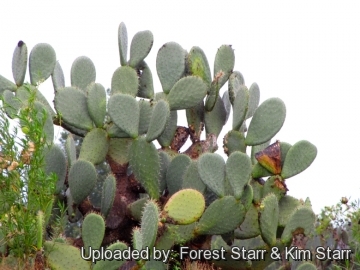
Habit at Kaonoulu Ranch Kula, Maui, Hawaii (USA). February 03, 2010. Photo by: Forest Starr & Kim Starr
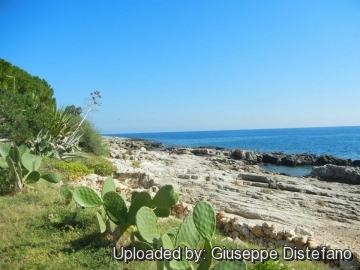
Fontane Bianche, Siracusa, Sicily, Italy. Photo by: Giuseppe Distefano
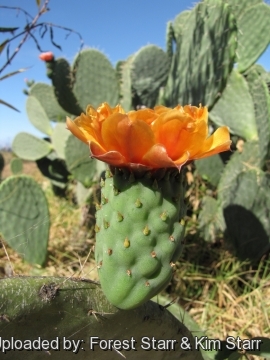
Flower and fruit forming at Kula, Maui, Hawaii (USA). August 30, 2011. Photo by: Forest Starr & Kim Starr
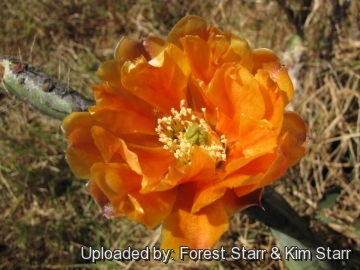
Flower at Kula, Maui, Hawaii (USA). August 30, 2011. Photo by: Forest Starr & Kim Starr

Opuntia ficus-indica Photo by: Julio C. García
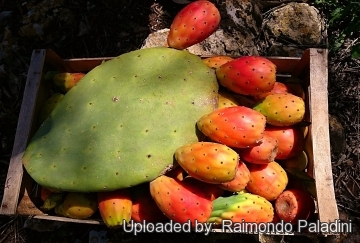
Opuntia ficus-indica Photo by: Raimondo Paladini

Young leaf and big headed ants Pheidole megacephala at Kula, Maui, Hawaii (USA). August 30, 2011. Photo by: Forest Starr & Kim Starr
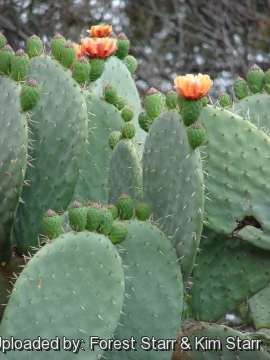
Flowers at Lower Kula Rd Kula, Maui, Hawaii (USA). April 26, 2009. Photo by: Forest Starr & Kim Starr
Cultivation and Propagation: Opuntia ficus-indica is a low maintenance plant that tolerate considerable neglect and will naturalize. Easy to cultivate outdoor in warm dry climates.
Growth rate: it is a relatively fast growing species that can form large clumps just in a few year and fruits can be harvested 3 years after planting.
Soils: It grows well in sandy or gravely, well-drained soils. May be grown in clay soils as long as drainage is good and soils do not remain wet, it is very adaptable both in acid, neutral and basic (alkaline) soils, but prefers a pH in the range 6 to 7,5. For pot culture it needs regular cacti soil with little organic matter (peat, humus).
Repotting: Since they are big-sized plants, they need plenty of space for their roots. Repotting should be done every other year, or when the plant has outgrown its pot. Use pot with good drainage.
Watering Needs: Must be kept fairly dry in winter but likes a reasonable supply of water in the growing season, but do not overwater and allow to dry fully before watering again, tolerate dry condition but suffer if exposed to prolonged and severe drought. A position at the base of a south-facing wall or somewhere that can be protected from winter rain is best for this plant, but is however resistant to moisture and rain. Care must be taken with watering as they tends to become swollen and untidy in growth habit if given too much water and shade.
Fertilization: During the growing season enrich the soil using a fertilizer rich in potassium and phosphorous, but poor in nitrogen, because this chemical element doesn’t help the development of succulent plants, making them too soft and full of water.
Sun Exposure: Full sun (only), in semi shaded position wont produce many flowers.
Hardiness: Reputedly sensitive to frost, but less so if kept on the dry side prior to, and during, cold weather (hardy to -5° C or less for short periods, depending on clone). However some warmth throughout the year will increase the grower's success (minimum 5° to 8°C during rest season). In presence of high atmospheric humidity make sure that Opuntias are not exposed to freezing temperatures, or they may die. Outdoors this plant is very adaptable, as long as you avoid excessive humidity in the winter months (in good drained soils).
Garden uses: Excellent as landscape or patio plant. It is suitable for “desert” or “Mediterranean” gardens, in association with other xerophytes. Where the open air cultivation is not possible due to the climate, it is to be cultivated in pot in order to shelter it in winter.
Traditional uses: Opuntia ficus-indicaSN|11631]]SN|11631]] is cultivated in more than 30 countries for its large, sweet fruits, called tunas, young cladodes (as vegetables) and mature cladodes for forage. The name "tuna" is not only used for the fruit of this cactus, but for Opuntia in general. The fruit are typically eaten, minus the thick outer skin, and can cause constipation if consumed with the seeds, without the seeds they are laxative. Jams and jellies are produced from the fruit, which resemble strawberries and figs in colour and flavour. Mexican eat the young cactus pads (nopales), usually picked before the spines harden. They are sliced into strips, skinned or unskinned, and fried with eggs, served as a breakfast treat. They have a texture and flavor like string beans. Moreover Mexicans have used Opuntias for thousands of years to make an alcoholic drink called colonche. Many Opuntias cultivars have been created for their improved nutritional or agronomic interests, such as higher yields, higher protein content, resistance to cold, resistance to insects and absence of spines. Opuntia ficus-indicaSN|11631]]SN|11631]] well as other species in Opuntia and Nopalea is cultivated as a host plant for cochineal insects, which produce desirable red and purple dyes. This practice dates from pre-Columbian times. Opuntia species are also used to prevent soil erosion (by providing cover) and desertification. Also, they protect the local fauna by surviving in very arid conditions. Spineless varieties are particularly interesting for fodder.
Pests & diseases: It may be attractive to a variety of insects, but plants in good condition should be nearly pest-free, particularly if they are grown with good exposure and ventilation.
Warning: Opuntias bear spines and glochids (stiff bristles on the surface of the cladode) that can be very irritating to the skin.
Propagation: Propagated almost exclusively by cuttings of leaf pads at any time in the growing season. It may also be propagated by seeds. Seeds germinate in 7-14 days at 21-27° C in spring, remove the glass cover gradually as the plants develops and keep ventilated, no full sun for young plants! The seedlings should not be disturbed until they are well rooted, after which they can be planted separately in small pots.
| Your Actions | |
|---|---|
| Back to Opuntia index | |
| Back to Cactaceae index | |
 |
Back to Cacti Encyclopedia index |
Privacy stantement - Terms and conditions - How to cite - About us - Feedback - Donate





